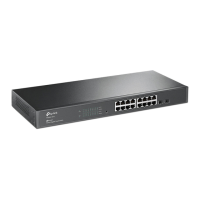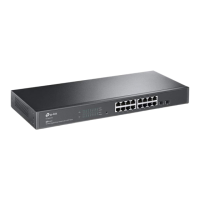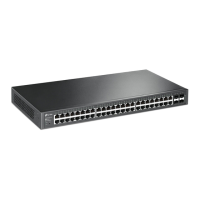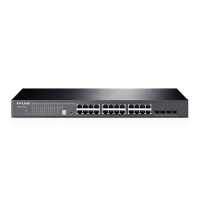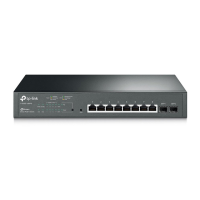
Do you have a question about the TP-Link T1600G-52PS and is the answer not in the manual?
| PoE Ports | 48 |
|---|---|
| Switching Capacity | 104 Gbps |
| Forwarding Rate | 77.4Mpps |
| PoE Budget | 384 W |
| Power Supply | AC 100-240V, 50/60Hz |
| Mounting | Rack Mountable |
| MAC Address Table | 16K |
| Jumbo Frame | 9KB |
| Packet Buffer Memory | 4 MB |
| Operating Temperature | 0°C to 40°C |
| Storage Temperature | -40°C to 70°C |
| Operating Humidity | 10% to 90% non-condensing |
| Storage Humidity | 5% to 90% non-condensing |
| Layer | Layer 2+ |
| Dimensions (W x D x H) | 440 x 44 x 44 mm |
| Standards and Protocols | IEEE 802.3u, IEEE 802.3ab, IEEE 802.3x, IEEE 802.3af, IEEE 802.3at |
| Quality of Service | 8 queues per port |
| VLAN | 4K VLANs |
| Management | Web-based, SNMP |
| Security | 802.1X |
| Ports | 48 x 10/100/1000 Mbps RJ45 ports, 4 x 1G SFP slots |
This Guide is intended for network managers familiar with IT concepts and network terminologies.
Details the conventions used in the guide, including font usage and symbols for notes.
Provides links to download center, installation guides, specifications, and support forums.
Introduces accessing and managing the switch via GUI or CLI, highlighting differences.
Explains how to access the switch's web interface through web-based authentication.
Details methods for accessing the switch's command line interface via console, Telnet, or SSH.
Covers system module configurations, including system information, user management, and access security.
Describes how to view system summary, specify device description, and set system time.
Explains how to create admin accounts and accounts of other types using GUI and CLI.
Details configurations for boot file, configuration restore, firmware upgrade, reboot, and reset.
Covers configuring access control, HTTP, HTTPS, SSH features, and enabling Telnet.
Explains how to configure system resources using SDM templates for optimized support.
Lists default settings for System Info, User Management, and System Tools configurations.
Introduces physical interfaces, their overview, and supported features like Basic Parameters, Port Mirror, Port Security.
Details how to configure basic parameters for ports using GUI and CLI, including Jumbo frames.
Explains how to configure port mirroring to monitor traffic and troubleshoot network problems.
Describes how to limit MAC addresses learned on a port to prevent MAC address table exhaustion.
Explains how to restrict ports to communicate only with specified ports or LAGs.
Details how to enable loopback detection to prevent loops and block affected ports.
Provides examples for Port Mirror and Port Isolation configurations.
Overview of Link Aggregation Group (LAG) function, static LAG, and LACP.
Steps to configure global load-balancing algorithm and static LAG or LACP.
Provides a detailed example for configuring LAG between two switches using LACP.
Lists the default parameters for LAG configuration.
Explains how to monitor traffic using Traffic Summary and Traffic Statistics.
Lists the default parameters for traffic monitoring features.
Overview of the MAC address table, its structure, and supported features.
Details on adding static MAC entries, modifying aging time, adding filtering entries, and viewing entries.
Covers configuring MAC notification traps and limiting the number of MAC addresses in VLANs.
Provides an example for configuring VLAN security and MAC notification.
Lists the default parameters for MAC Address Table configurations.
Explains VLAN technology, its benefits for broadcast domain restriction, network security, and management.
Steps to configure 802.1Q VLAN, including PVID and VLAN creation.
Provides a configuration example for VLAN setup in a departmental network scenario.
Lists the default parameters for 802.1Q VLAN configurations.
Explains MAC VLAN, its advantages over port-based VLANs for dynamic topology changes.
Steps to configure MAC VLAN: create 802.1Q VLAN, bind MAC to VLAN, and enable MAC VLAN on ports.
Provides a configuration example for MAC VLAN setup across multiple switches.
Lists the default parameters for MAC VLAN configurations.
Explains Protocol VLAN technology for dividing VLANs based on network layer protocols.
Steps to configure Protocol VLAN: configure 802.1Q VLAN, create protocol template, and configure Protocol VLAN.
Provides a configuration example for Protocol VLAN to forward IPv4 and IPv6 packets to respective networks.
Lists the default parameters for Protocol VLAN configurations.
Overview of Spanning Tree Protocol (STP), Rapid STP (RSTP), and Multiple STP (MSTP).
Steps to configure STP/RSTP parameters on ports, globally, and verify configurations.
Details MSTP configuration: parameters on ports, MSTP region, global MSTP, and verification.
Covers configuring Loop Protect, Root Protect, TC Protect, BPDU Protect, and BPDU Filter functions.
Provides a configuration example for MSTP to enable load-balancing across VLANs.
Lists the default parameters for Spanning Tree configurations.
Overview of Layer 2 Multicast, its benefits, and role in network applications.
Steps to configure IGMP Snooping globally, on ports, in VLANs, and related parameters.
Details MLD Snooping configurations: globally, on ports, in VLANs, and related parameters.
Describes how to view IPv4 and IPv6 Multicast Snooping configurations using GUI and CLI.
Provides configuration examples for Basic IGMP Snooping, Multicast VLAN, and Unknown Multicast/Fast Leave.
Lists the default parameters for IGMP Snooping.
Introduces interfaces, classifying them into physical and logical, and lists supported logical interface types.
Details IPv4 and IPv6 interface configuration, including creating interfaces and viewing information.
Lists the default parameters for IPv4 and IPv6 interface configurations.
Explains static routing, its benefits for network connectivity, and support for IPv4 and IPv6 static routing.
Steps to configure IPv4 static routes using GUI and CLI, including destination, mask, and next hop.
Details on configuring static IPv6 routing, including destination, prefix length, next hop, and distance.
Describes how to view IPv4 and IPv6 routing tables using GUI and CLI.
Provides a configuration example for static routing setup between two switches.
Lists the default parameters for static routing configurations.
Overview of DHCP, its role in dynamic IP assignment, and supported features like Relay and Client.
Steps to configure the switch as a DHCP client using GUI and CLI.
Details DHCP Relay configuration, including Option 82 and specifying DHCP servers.
Provides configuration examples for DHCP Interface Relay.
Lists the default parameters for DHCP Relay and DHCP Client configurations.
Explains ARP (Address Resolution Protocol) and its function in mapping IP to MAC addresses.
Details on viewing ARP entries, adding static ARP entries, configuring ARP function, and clearing entries.
Overview of Quality of Service (QoS) technology for traffic classification and prioritization.
Steps to configure priority modes (802.1P, DSCP, Port) and schedule modes (SP, WRR, SP+WRR, Equ).
Details on Rate Limit and Storm Control functions to manage traffic rates and prevent broadcast storms.
Provides a QoS configuration example to prioritize voice traffic using Port Priority and SP schedule mode.
Lists the default parameters for DiffServ and Bandwidth Control configurations.
Explains the voice VLAN feature for prioritizing voice traffic and its modes.
Steps to configure Voice VLAN: create VLAN, configure OUI, globally, and on ports.
Provides configuration examples for voice VLAN setup in office and meeting room scenarios.
Lists the default parameters for Voice VLAN configurations.
Overview of Power over Ethernet (PoE), its standards, PSE, and PD.
Details on configuring PoE parameters manually and using profiles.
Explains creating time-ranges, configuring holidays, and viewing time-range tables.
Provides a PoE configuration example for office area and meeting room scenarios.
Lists the default parameters for PoE configurations.
Overview of ACL (Access Control List) for traffic filtering, security, and service quality.
Steps to configure ACL Binding and Policy Binding using GUI and CLI.
Provides a configuration example for Extend-IP ACL to filter traffic for marketing department.
Lists the default parameters for MAC, Standard-IP, Extend-IP, and IPv6 ACLs.
Overview of network security features like IP-MAC Binding, DHCP Snooping, ARP Inspection, DoS Defend, 802.1X, and AAA.
Details on manual and dynamic IP-MAC binding, including ARP scanning and DHCP snooping.
Steps to configure DHCP Snooping globally, on ports, and optionally Option 82.
Covers configuring ARP Detection, ARP Defend, and viewing ARP statistics.
Details on configuring DoS Defend feature to protect against various DoS attack types.
Steps to configure 802.1X globally and on ports, including RADIUS server setup.
Explains AAA configuration, including enabling AAA, adding servers, groups, method lists, and application lists.
Provides configuration examples for DHCP Snooping/ARP Detection and 802.1X authentication.
Lists the default parameters for Network Security features like IP-MAC Binding, DHCP Snooping, ARP Inspection, DoS Defend, 802.1X, and AAA.
Overview of LLDP (Link Layer Discovery Protocol) and LLDP-MED for neighbor discovery and auto-configuration.
Steps to configure LLDP globally and on ports using GUI and CLI.
Details LLDP-MED configurations: globally and on ports, including device class and TLVs.
Describes how to view local and neighbor LLDP information using GUI and CLI.
Explains how to view LLDP-MED local and neighbor information using GUI.
Provides a configuration example for LLDP and LLDP-MED setup.
Lists the default parameters for LLDP and LLDP-MED configurations.
Overview of the maintenance module and its supported features for network troubleshooting.
Details on monitoring CPU and memory utilization using GUI and CLI.
Explains configuring local logs, remote logs, backing up log files, and viewing the log table.
Covers cable testing and viewing device diagnostics.
Details on configuring Ping and Tracert tests for network connectivity diagnosis.
Provides an example for configuring remote log settings.
Lists the default parameters for maintenance features like Ping and Tracert.
Overview of SNMP, its role in device management, and supported versions.
Steps to configure SNMPv1, SNMPv2c, and SNMPv3, including views, groups, and users.
Covers configuring SNMP traps and informs to send notifications to NMS.
Overview of RMON for remote network monitoring, its components, and data collection.
Steps to configure RMON statistics, history, event, and alarm entries.
Provides a configuration example for SNMP, bandwidth control traps, RMON, and event/alarm configurations.
Lists the default parameters for SNMP configurations.

